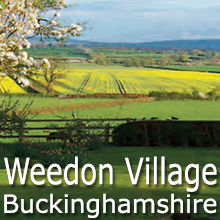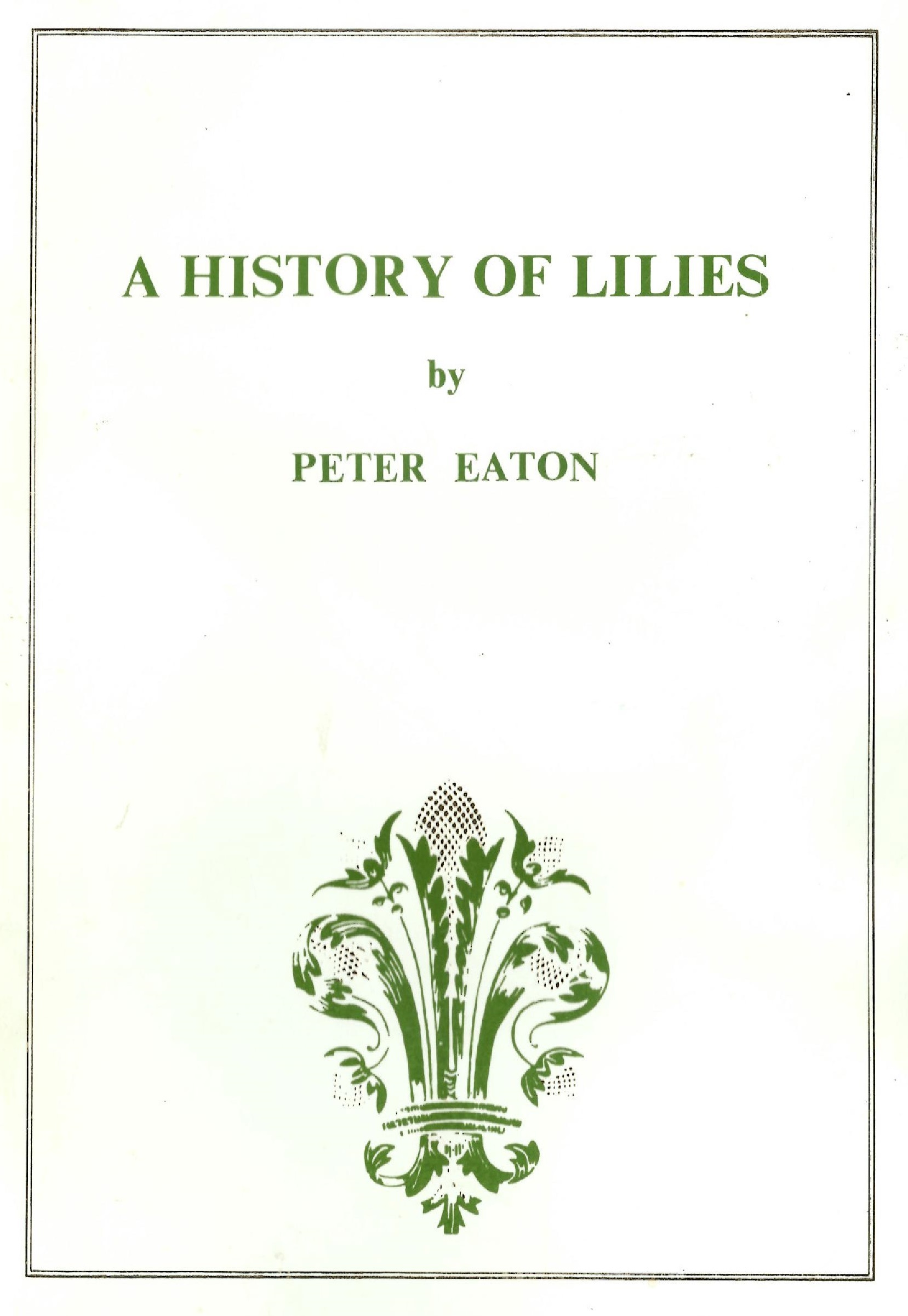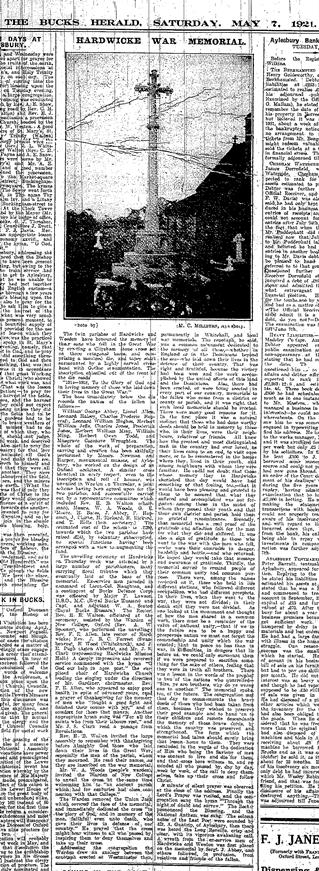Welcome to our lovely conservation village of 160 homes to the north of Aylesbury.
Weedon is an active community of farmers, professionals, working families and retired people who enjoy a quality village life in central Bucks.
Two Weedon stories by Rev E Ralph Bates
Ralph Bates lived from 1897 to 1997. He researched and wrote much about Weedon and his family history in the village. These are two of his unpublished manuscripts.
The Place Where We Were Born
He wrote this "outline study" in an exercise book and sent it to J.T.S. Rolls in Whitchurch in 1968. David Rolls transcribed the manuscript and produced this typed version.
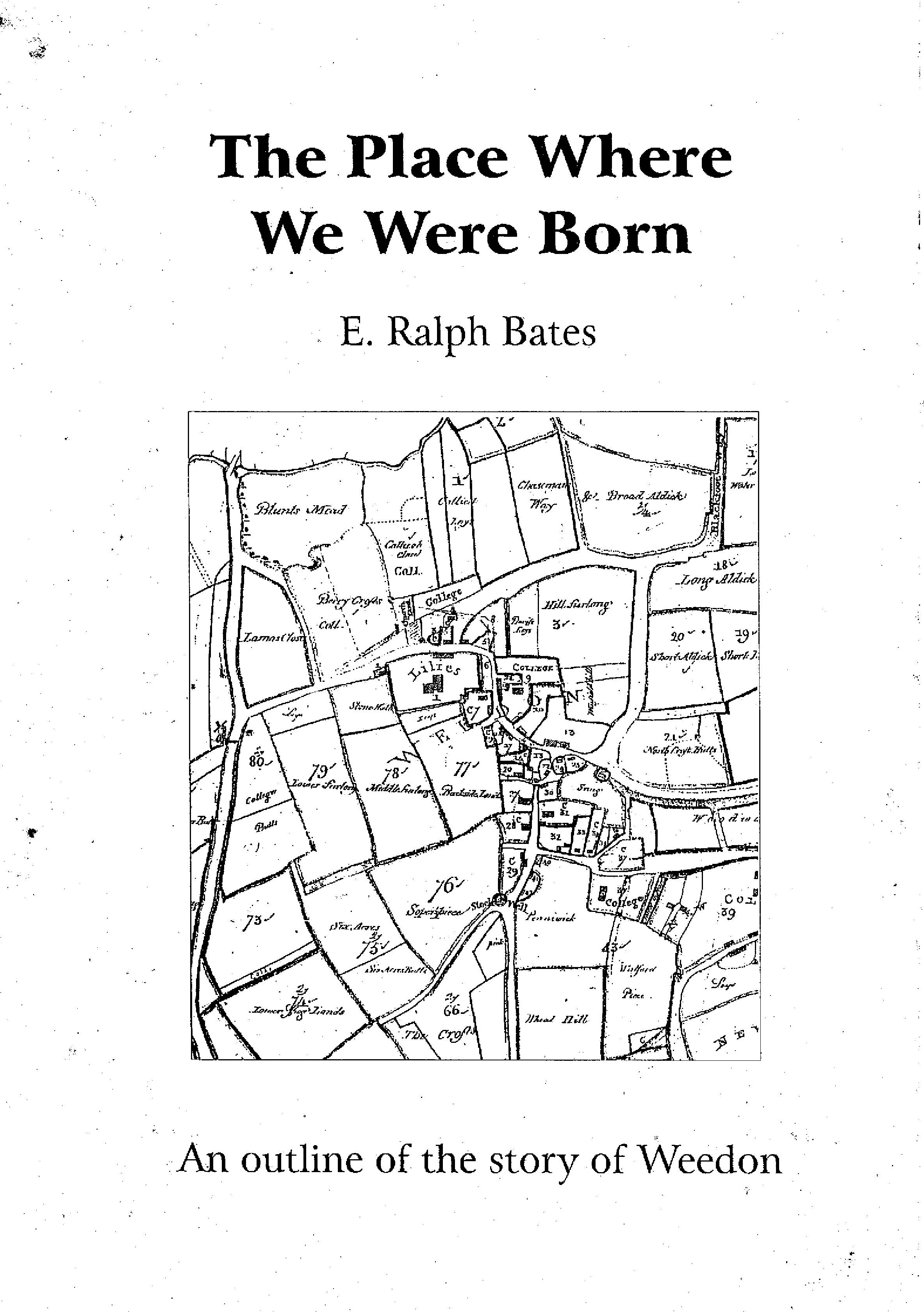
A Weedon Story of Two Families - Rolls and Seamons
Ralph Bates wrote this "story" of the Rolls and Seamons families in Weedon in 1969.
Peter and Margaret Eaton owned Lilies from 1969 until the 1990s. They lived in the house and also ran a bookselling business from it.
Peter Eaton wrote this booklet on the history of Lilies in 1986. There are printed copies still around in the village, and we felt it was worth publishing the text online. Click HERE or on the picture for the pdf.
Weedon War Memorial - A personal journey of discovery in 2009 by Ralph Followell, Weedon resident
Download a pdf of the full publication by Ralph Followell here.
The War Memorial Weedon & Hardwick
STORIES OF THE FORGOTTEN FALLEN
FOREWORD
Yorkshire stone can become hazardous to walk on when wet due to a green slimy mould which grows on it. After cleaning the path to the Chapel with a new pressure hose, it was so easy to see that the War Memorial which stands in the grounds of the Chapel in Weedon could do with a cleanup too. What was not easy was to see the names of the men recorded there.
After some difficulty, all were identified, and the Parish Council had brass plates made which are now attached to the memorial and copies displayed inside the Chapel so that their names would be preserved.
With the exception of the Ming family, it was realised that none of those recorded had any descendents living in Weedon.
The memorial was erected in the early 1920s by the Parish Council with a similar one in Hardwick. The names are the same on both memorials.
This publication is the result of an attempt to find out as much as possible about these men from historical records.
It has been my privilege to visit every grave and memorial of all but Charles Jones, who died in Basra in Iraq. It took me to Northern France and Belgium. What follows is hopefully correct, but I would appreciate any help with any incorrect factual information herein.
It is a deeply moving and humbling experience to stand in the cemeteries and memorials of these men and spend a few moments reflecting and praying for them. They gave their lives so that those like me could enjoy the life we have.
Three were aged 19; five were in their 20s and three in their 30s with one a 43-year-old. The only one who was married, Leonard Halsey (to Vera Ming), had a daughtehe probably never saw, who died and was buried on 5th May just two months after his death.
-----
Weedon War Memorial - Bucks Herald report 1921
|
The Bucks Herald Saturday 7th May 1921 [transcribed by Ralph Followell 2009] The twin parishes of Hardwicke and Weedon have honoured the memory of their sons who fell in the Great War by erecting a Clipsham stone cross set on three octagonal bases and comprising a moulded die, and taper shaft surmounted by a highly carved cross-head with Gothic ornamentation. The inscription chiselled out on the front of the die reads “1914-1918, To the Glory of God and in loving memory of those who laid down their lives in The Great War”. The base immediately below the die records the names of the fallen as follows:- William George Abbey, Lionel Allen, Leonard Halsey, Charles Frederic Hopcraft, Leonard Williams Hughes, Herbert William Jeffs, Charles Jones, Frederick Jones, Herbert William Ming, William Ming, Herbert Owen Todd, and Musgrave Cazenove Wroughton. The whole of the work of preparation, carving and erection has been skilfully performed by Messrs. Newman and Harper, monumental masons, of Aylesbury, who worked on the design of an Oxford architect. A similar cross, identical in every respect, even to the inscription and roll of honour was unveiled in Weedon on Thursday, a joint scheme having been agreed for the two parishes, and successfully carried out by a representative committee which included Rev. H.B.Walton (Chairman), Messrs W.A. Woods, G.E. Moore, H. Bates, J. Abbey, F. Hopcraft, J. Clarke, H. Rickard, R. Rickard and T. Rolls (hon. secretary). The estimated cost of the scheme is £390, towards which the two parishes have raised £345 by voluntary subscription, no special functions having been arranged with a view to augmenting the fund. The unveiling ceremony at Hardwicke on Thursday week was attended by a large number of parishioners, many carrying floral tributes which they eventually laid at the base of the memorial. Ex-service men paraded in command of Lieut.-Col. Haughton and a contingent of Bucks Defence Corps. was officered by Major F. Lawson D.S.O., M.C. (Royal Bucks Hussars) and Capt. and Adjutant W.A.Seaton (Royal Bucks Hussars). The Rector Rev. H.B. Walton officiated at the ceremony, assisted by the Warden of New College, Oxford (Rev. A.W. Spooner), who performed the unveiling. Rev. F.E. Allen, late rector of Hardwicke; Rev. J.R.C. Forrest (Swanbourne), H.Wood (Whitchurch) and J.E. Pugh (Aston Abbotts), and Mr. J.S.Clark (representing Hardwicke Mission Hall). A deeply impressive and reverent service commenced with the hymn “O God our help in ages past”, the surpliced choir of Hardwicke Church leading the singing under the direction of Mr. Gardiner, choir master. Rev. F.E.Allen, who appeared to enjoy good health in spite of advancing years, read a prayer of thanksgiving for the memory of men who “fought a good fight and finished their course with joy,” and of comfort for those that mourn. Another appropriate hymn sung was “For all the saints who from their labours rest,” and Mr. J.S. Clark read a passage from Revelations. Rev. H.B.Walton invited the large assembly to remember with thanksgiving before Almighty God those who laid down their lives in the Great War, especially the men of the parish, whom they mourned. He read their names, as they are inscribed on the war memorial. Mr. W.A.Woods (people’s warden), invited the Warden of New College to unveil the cross, at the same time welcoming him to “An ancient parish which had for centuries had close connection with that College”. The Warden removed the Union Jack which covered the face of the memorial, and immediately dedicated the cross “to the glory of God and in memory of the men, faithful even unto death, who gave their lives in defence of our country”. He prayed that the cross might bear witness to all who passed by, inspiring them to deny themselves and take up their cross. Addressing the congregation the Warden drew an analogy between the cenotaph erected at Westminster then permanently in Whitehall, and local war memorials. The cenotaph, he said, was a common monument dedicated to the memory of all those – whether in England or in the Dominions beyond the sea – who laid down their lives in the defence of their country. That was right and truthful, because the victory had been won and the work accomplished by the united efforts of this land and the Dominions. Also, there had been erected, or were being erected in every part of our country, memorials to the fallen who came from a district or county or parish, and it was right that such local memorials should be erected. There were many good reasons for it. In the first place it was a natural instinct that those who had done worthy deeds should be held in memory by those who, in their lives, were their neighbours, relatives or friends. All knew how the greatest and most distinguished men in the country had ever loved, as their lives came to an end, to visit once more, or to be remembered in the houses where they lived in their youth, and among neighbours with whom they were familiar. He could not doubt that those whose memory they in Hardwicke cherished that day would have had something of that feeling, too – that it would have been pleasing and grateful to them to be assured that what they suffered and accomplished was not forgotten among those in the midst of whom they passed their youth and that their own district and parish held them in grateful remembrance. Secondly, that memorial was a real proof of the gratitude and affection felt for the men for what they did and suffered. It was also a sign of gratitude to those who went to war with the men who fell – who were their comrades in danger, hardship and battle – and who returned. He hoped they would take that message and assurance of gratitude. Thirdly, the memorial served to remind people of their common unity and common purpose. There were, among the names recorded on it, those who held in life different stations, who followed different occupations, who had different prospects. In their lives, when they went to the war, they were not divided; in their death still they were not divided. As one looked at the monument and thought of how the men shared in a common work, there must be a reminder of the value of national unity – that if we in the future are to be a happy and prosperous nation we must not forget the comradeship and unity which the war created; that in peace no less than in war, in difficulties, in dangers that lie before us , we could only surmount them if we were prepared to sacrifice something for the sake of others, feeling that they were in truth all brothers. There was a lesson in the words of the prophet to two of the nations who quarrelled – “Sirs, ye are brothers, why do ye wrong one to another”. The memorial spoke too of the future. The congregation met that day to commemorate the brave deeds of those who had been taken from them, because they wished to preserve their good example and to hand on to their children and remote descendants the memory of those brave deeds, by which the country was preserved and strengthened. The form which the memorial had taken should surely bring that lesson home to them. They were reminded in the words of the dedication of Him who being the Saviour of men was content to live and die for them, and that cross bore witness to, and reminded all who passed by, day by day, week by week, of the call to deny themselves, take up their cross and follow Christ. A minute of silent prayer was observed at the close of the address. Finally the Lord’s Prayer was recited and the congregation sang the hymn “Through the night of doubt and sorrow”. The Rector pronounced the Blessing and the National Anthem was sung. The solemn notes of the Last Post were sounded by Mr A. Guntrip, of Aylesbury, then there was heard the Long Reveille, crisp and clear, with its vigorous awakening call. A wreath from the ex-service men of Hardwicke and Weedon was first placed on the memorial by Sergt. J. Abbey and others followed, in profusion, from relatives and friends of the fallen. |
|
-----
THE WAR ON THE WESTERN FRONT, 1914 – 1918
In the First World War, the Western Front – a battle line extending from the Channel coast to Switzerland along which for four years, millions of men fought and died – was the principal and vital theatre. Against the German Army were arrayed the Armies of the British Commonwealth, France, Belgium and latterly, the United States. The first two months, a war of movement, saw the containment and partial repulse of the initial German thrust. There then followed three and half years of static trench fighting, a war of attrition, during which defensive power was paramount. Neither side could effect a breakthrough, and great battles were fought for small territorial gains. The last seven months were again, a war of movement, culminating in the Allied offensive, starting in August, which finally achieved the breakthrough leading to the Armistice of 11th November 1918.
The six divisions of the British Expeditionary Force which went to France at the outset in 1914 were deployed amongst the French armies and played their full part from 23rd August in the Battle of Mons, Le Cateau, the Marne and the Aisne. The next three weeks during which the battle line moved every day, were a highly critical period in which the German plan for ending the war at a stroke was foiled and the issue deferred.
In the first two weeks of October, the BEF was moved from the central sector of the front to Flanders. This move shortened its lines of communication, which ran through Dunkirk, Calais and Boulogne and enabled it to protect these ports which were vital both to its own supply and reinforcement and to the Royal Navy’s command of the Channel. Over the next four years during which its strength rose to fifty British and twelve overseas Commonwealth divisions – Canadian, Australian, New Zealand, South African, Indian and troops from Newfoundland, the British West Indies and other territories – the BEF progressively took over more of the northern sector of the Allied line and fought a series of battles of attrition of which the greatest was the First Battle of the Somme in 1916.
After the German offensives of late March to mid July 1918 had been contained, the advance to victory began on 8th August with the Battle of Amiens, continued on a broadening front with the Second Battles of the Somme and of Arras and, in September, extended to the Ypres Salient. The advance swiftly gathered momentum and by the day of the armistice the front line ran fifty miles or more eastward of the starting points.
Nearly 750,000 Commonwealth soldiers, sailors and airmen died of the Western Front. 200,000 in Belgium and over 500,000 in France. They are commemorated upon headstones marking graves in over 1,000 war cemeteries and 2,000 civil cemeteries or on one of the six memorials in Belgium and twenty in France which carry the names of more than 300,000 who have no known grave.
READ THE BIOGRAPHIES OF THE FORGOTTEN FALLEN BY CLICKING ON THE NAMES
| Forgotten Fallen of World War I | Born in | Died | Commemorated/Buried |
| William George ABBEY | Weedon | 30 Sept 1918 | Haringhe Military Cemetery, Poperinge, Belgium |
| Lionel Edward ALLEN | Hardwick | 2 January 1918 | Rocquigny-Equancourt Road British Cemetery, Manancourt, Somme, France |
| Leonard HALSEY | Weedon | 23 March 1918 | Pozieres Memorial, Albert, Somme, France |
| Charles Frederick HOPCRAFT | Hardwick | 26 April 1917 | Chapelle British Cemetery, Holnon, Aisne, France |
| Leonard William HUGHES | Hardwick | 23 March 1918 | Grevillers British Cemetery, nr Bapaume, France |
| Herbert William JEFFS | Weedon | 22 August 1917 | Tyne Cot Memorial, Passchendaele, Belgium |
| Charles JONES | Weedon | 8 April 1916 | Basra Memorial, Iraq |
| Frederick JONES | Weedon | 11 September 1918 | Vis-enArtois Memorial, Arras, France |
| Herbert William MING | Weedon | 13 March 1915 | Le Touret Memorial, Bethune, Pas de Calais, France |
| William George MING | Weedon | 27 August 1917 | Tyne Cot Memorial, Passchendaele, Belgium |
| Herbert Owen TODD | Hardwick | 20 July 1917 | St Mary's Churchyard, Hardwick |
| Musgrave Cazenove WROUGHTON | Weedon | 30 October 1914 |
Kemmel Churchyard, Kemmel, Belgium |
-----
REFLECTIONS
William George Ming and Herbert Jeffs died within 5 days of each other and their names are recorded on the panels, albeit under different Regiments, at the Tyne Cot Cemetery in Belgium. William was 23 years older than Herbert, but they lived, according to the census records, in Providence Place. William would have known Herbert throughout his life from a small baby to a young adult. Being in different Regiments, they may not have known that they were both in Belgium and indeed at the Battle of Passchendaele. They both may be buried in one of the 8,637 unnamed, out of the 11,954, graves of those soldiers who fell during the fighting there in August 1917.
Herbert William Ming joined the Grenadier Guards but would have known Herbert Jeffs and his cousin (first removed) William. If you examine the Weedon census records over a number of decades, you soon realise that there were a number of families who lived in adjacent dwellings in Providence Place. The Ming’s lived at No. 55; both father George in 1881 and then son Tom with grandson Herbert William after 1891. The Jeffs were at No. 63 from 1891 onwards. When son Tom, after 1891, took over No. 55, George and his wife with unmarried son William George moved into No. 61. Tom’s wife was Annie Arnold, and the Arnold family lived at No.59.
Two Leonards died on the same day in March 1918, one Leonard Hughes, from Hardwick, of the Hampshire Yeomanry, who was helping defend positions during the sixteen days of the German big advance and the other Leonard Halsey, from Weedon, of the Queens Royal West Surrey Regiment who was in the same area of conflict. Their cemeteries are less than 10 kilometres apart. Leonard Halsey came from Aston Abbotts and married Vera Ming the daughter of Tom Ming whose son Herbert William had died in 1915.
All these four men – Herbert William Ming, William George Ming, Herbert Jeffs and Leonard Halsey – would have known each other well. They joined different Regiments and saw different areas of France and Belgium. None of them has a known grave and it is only on the panels of their Regiments that their names are found, although there are many graves in the cemeteries where they could be. Sadly, some of them may have no remains, as nothing of them was ever found.
By contrast, all of the men lost from Hardwick have graves and lie with comrades from the battles in which they fought. Lionel Allen, Charles Hopcraft andLeonard Hughes are buried in France within 20 kilometres of the British Memorial at Thiepval. Herbert Todd is in Hardwick cemetery.
William Abbey, who rests in Belgium, was the only man born in Weedon to have a known grave and was the last man in the villages to die. Frederick Jones is listed on a memorial east of Arras and his brother Charles is somewhere in Basra, in Iraq. These three may well have known each other as they all resided, before the war, in Stockaway. Charles and Frederick Jones were the sons of the publican who lived at the Five Elms from 1899 to 1917.
Musgrave Wroughton,who was apparently known as Bob by all who knew him, was also buried and was the first soldier in the villages to be killed. However, he was born, not in Weedon, but in London.
His mother was married in Hardwick Church, but the family left Weedon before Musgrave was born. A plaque was placed by his mother in Hardwick Church and his grandparents Henry Cazenove and wife were known benefactors. Maybe Musgrave’s mother helped towards the costs of erecting the memorials in both villages. Maybe she felt that, as her son went to school in Harrow and Oxford and then joined the army, he had no real roots in London, and Weedon was her childhood home. Who knows? There is no doubt that he had a very distinguished service career and was a very gallant soldier, who was very attached to his mother’s childhood family home.
Nothing, of course, in this appraisal refers to the many men who served in the war and returned home wounded, lost limbs, suffered from shell shock, were gassed and then may have had to contend with Spanish Flu.
‘The War to end all Wars’ certainly failed to achieve that hope.
Ralph A Followell 2024
Weedon, an old English word, means “pagan shrine on a hill”. The pagan Anglo-Saxons settled in Buckinghamshire from the fifth century onwards, so the name possibly indicates a comparatively late survival of pagan practices.(1)
Archaeological surveys have found Neolithic to Bronze Age flints and Roman remains in various parts of the parish suggesting the possibility of a much earlier settlement.(2)
The Doomsday Book
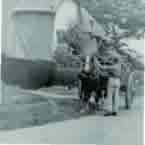 Although Weedon is mentioned in a will dated 944, it is not named in the Domesday Book of 1086, but is included in the three land-holdings listed for Hardwick. The largest of these was Hardwick Manor and the second is believed to have been called Weedon-in-the-Vale Manor in the 14th century and Kempton’s Fee in the 16th and 17th centuries. The smallest, on which may have stood a dovecot and windmills, may have become part of the Weedon manor.(3)
Although Weedon is mentioned in a will dated 944, it is not named in the Domesday Book of 1086, but is included in the three land-holdings listed for Hardwick. The largest of these was Hardwick Manor and the second is believed to have been called Weedon-in-the-Vale Manor in the 14th century and Kempton’s Fee in the 16th and 17th centuries. The smallest, on which may have stood a dovecot and windmills, may have become part of the Weedon manor.(3)
Descent of the Manors - Origin of the Two Weedon 'Ends'?
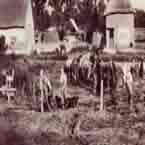 Hardwick Manor was inherited by two sisters in 1236 and from that date each half descended separately in ownership. In 1385, New College, Oxford acquired one half, with its base being at Weedon Lodge. Until parish boundary changes in 1886, Weedon Lodge, with 8 acres of land, was actually part of Wingrave parish, not Weedon.(4) The College still owns land at Weedon Hill.
Hardwick Manor was inherited by two sisters in 1236 and from that date each half descended separately in ownership. In 1385, New College, Oxford acquired one half, with its base being at Weedon Lodge. Until parish boundary changes in 1886, Weedon Lodge, with 8 acres of land, was actually part of Wingrave parish, not Weedon.(4) The College still owns land at Weedon Hill.
The other half-manor was conveyed to Robert Lee of Quarrendon in 1522. A year later, he also acquired the Weedon-in-the-Vale manor.(5) Lilies was the base of the Lees. This arrangement may account for the polyfocal layout of the village, with one centre at East End and the other at the High Street. The two parts are still separated by the field called The Closes.
Windmills in Weedon
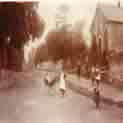 The mound in Lilies Park beside the Buckingham Road may be all that remains of one of the windmills mentioned above. In 1692, Elizabeth, Countess of Lindsey, of Lilies and her son, Henry, Earl of Litchfield, granted two parcels of land to Leonard Sharp, miller of Aston Abbotts. A substantial windmill was to be built on one parcel, on the site of a former ancient mill, and on the other a little house for the miller. The Windmill Field or Nap is referred to in several “glebe terriers” (land surveys), including that of 1605, and a windmill is shown on the pre-enclosure map of Weedon, albeit on the opposite side of the main road. The position of the road may have changed, however.(6)
The mound in Lilies Park beside the Buckingham Road may be all that remains of one of the windmills mentioned above. In 1692, Elizabeth, Countess of Lindsey, of Lilies and her son, Henry, Earl of Litchfield, granted two parcels of land to Leonard Sharp, miller of Aston Abbotts. A substantial windmill was to be built on one parcel, on the site of a former ancient mill, and on the other a little house for the miller. The Windmill Field or Nap is referred to in several “glebe terriers” (land surveys), including that of 1605, and a windmill is shown on the pre-enclosure map of Weedon, albeit on the opposite side of the main road. The position of the road may have changed, however.(6)
The Two Weedon Manors
 Each manor held its own manorial court which by the 1700s dealt predominantly with changes of tenants and the collection of monies due to the Lord of the Manor. The Lee manor let a number of farms and cottages, some of the latter with small amounts of land in the open fields and rights of pasture for two cows and six sheep.(7) A few cottages built on the manorial waste, for example in Stockaway, were allowed to remain for a nominal rent.(8)
Each manor held its own manorial court which by the 1700s dealt predominantly with changes of tenants and the collection of monies due to the Lord of the Manor. The Lee manor let a number of farms and cottages, some of the latter with small amounts of land in the open fields and rights of pasture for two cows and six sheep.(7) A few cottages built on the manorial waste, for example in Stockaway, were allowed to remain for a nominal rent.(8)
The "Copyhold System" of Tenure
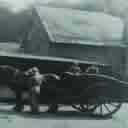 New College leased out College Farm (Weedon Lodge) but their remaining land was held by copyhold for ‘three lives’. A copyholder retained a copy of the entry made in the manorial court roll. He named two others to succeed him. Properties could stay in the same family for generations as long as they could afford the entry fines due on being admitted to the tenancy and for each life added. Many copyholds had been converted to leasehold during the 18th century, but this form of tenure continued in Weedon until the early 20th century, under the conservative management of New College. The Chestnuts, Lambsquay House, The Wheatsheaf and The Royal George, all dating from the 17th century, were copyhold properties.(9)
New College leased out College Farm (Weedon Lodge) but their remaining land was held by copyhold for ‘three lives’. A copyholder retained a copy of the entry made in the manorial court roll. He named two others to succeed him. Properties could stay in the same family for generations as long as they could afford the entry fines due on being admitted to the tenancy and for each life added. Many copyholds had been converted to leasehold during the 18th century, but this form of tenure continued in Weedon until the early 20th century, under the conservative management of New College. The Chestnuts, Lambsquay House, The Wheatsheaf and The Royal George, all dating from the 17th century, were copyhold properties.(9)
Weedon Lands before Enclosure
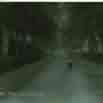 The land of both manors and about 138 acres of non-manorial freehold land lay intermixed in the three large open fields that surrounded the village. These fields were subdivided into named furlongs and each furlong into strips. Each year, one field lay fallow; one grew wheat and the other beans. Pasture was in short supply and the number of animals that could be kept was carefully regulated. There were also some old enclosed fields, for example Kirby’s, The Closes and Lammas Close.(10)
The land of both manors and about 138 acres of non-manorial freehold land lay intermixed in the three large open fields that surrounded the village. These fields were subdivided into named furlongs and each furlong into strips. Each year, one field lay fallow; one grew wheat and the other beans. Pasture was in short supply and the number of animals that could be kept was carefully regulated. There were also some old enclosed fields, for example Kirby’s, The Closes and Lammas Close.(10)
Weedon Act of Enclosure 1801
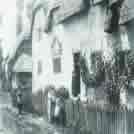 By the 18th century the open field system of farming was seen as inefficient and many parishes enclosed their fields by an act of parliament. The Weedon Act authorised the enclosure of allotments, by hedges and ditches, for the sole use of the owner or tenant. New roads were laid out including New Road and the Aston Abbotts Road, and some of the High Street was repositioned.
By the 18th century the open field system of farming was seen as inefficient and many parishes enclosed their fields by an act of parliament. The Weedon Act authorised the enclosure of allotments, by hedges and ditches, for the sole use of the owner or tenant. New roads were laid out including New Road and the Aston Abbotts Road, and some of the High Street was repositioned.
The Enclosure Award 1802 allotted 738 acres to New College, 502 acres to the Marquis of Buckingham (who bought the Weedon part of the Lee Manor in 1801) and 302 acres to the Church, in lieu of tithes.(11) Although the layout of Weedon was transformed by enclosure, the ridge and furrow clearly visible in many of the fields is evidence of mediaeval farming practices and has survived due to the conversion to pastoral farming after enclosure.
The Village Economy after Enclosure
 Enclosure did not result in mass exodus, but some families emigrated to Australia in the 1840s.(12) The population rose from 385 in 1801 to 463 in 1871 before dropping to 321 in 1901.(13)
Enclosure did not result in mass exodus, but some families emigrated to Australia in the 1840s.(12) The population rose from 385 in 1801 to 463 in 1871 before dropping to 321 in 1901.(13)
Agriculture was still the major source of employment with most men working as labourers. Women and children supplemented the family income by straw-plaiting and lace-making, with 93 involved in these crafts in 1851. This figure dropped to 14 in 1881 due to the strong competition from foreign imports.(14) Many women left the village to search for work elsewhere. It was not until the early twentieth century that the crafts of blacksmith, tailor and baker that had made the village fairly self-sufficient disappeared. The last shop closed in 1990.
The Three Weedon Pubs
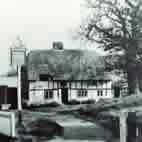 For a short while there were three public houses licensed in Weedon. A pub was licensed in 1754 which was probably the Five Elms, but the name did not appear until 1777. The Crown and Wheatsheaf, later just the Wheatsheaf, was licensed from 1815 and closed in the 1950s. The Horse and Jockey at Weedon Hill was licensed in 1818, but it only remained a pub for a few years before becoming the Horse and Jockey farm by the 1850s.(15)
For a short while there were three public houses licensed in Weedon. A pub was licensed in 1754 which was probably the Five Elms, but the name did not appear until 1777. The Crown and Wheatsheaf, later just the Wheatsheaf, was licensed from 1815 and closed in the 1950s. The Horse and Jockey at Weedon Hill was licensed in 1818, but it only remained a pub for a few years before becoming the Horse and Jockey farm by the 1850s.(15)
Lilies and the Rothschilds in Weedon
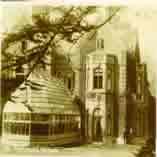 In 1848, the Buckinghams were forced to sell their land holdings in and around Aylesbury. Lord Nugent, the first Duke of Buckingham’s brother, bought the house and parkland. The remainder of the Weedon estate was purchased by Baron Anthony de Rothschild of Aston Clinton in 1849.(16) On Lord Nugent’s death in 1850, Lilies was inherited by Dr Connell, a relative of Nugent’s wife.
In 1848, the Buckinghams were forced to sell their land holdings in and around Aylesbury. Lord Nugent, the first Duke of Buckingham’s brother, bought the house and parkland. The remainder of the Weedon estate was purchased by Baron Anthony de Rothschild of Aston Clinton in 1849.(16) On Lord Nugent’s death in 1850, Lilies was inherited by Dr Connell, a relative of Nugent’s wife.
In 1869, Lilies house and grounds were bought by Henry Cazenove, a stockbroker from London. He had the old house pulled down and rebuilt in 1870.(17) Henry Cazenove died in 1894 and the house was put up for sale. It continued in private hands until 1939, when it was taken over by a firm of distillers. From 1946 it was used as a training centre for the Royal Bucks Hospital, but reverted to private ownership in 1969.(18)
Education and Schools
 Entries in 19th century marriage registers show that many could not sign their name, but a number of attempts had been made to educate at least some of the children. A young woman ran a school in Weedon in 1712. A daily school commenced in 1831, in which twenty boys and girls were instructed at the expense of their parents. A Sunday school supported by voluntary contributions started in the same year. Dr Bridle founded two schools in Hardwick, in the late 18th century, one for boys and one for girls, and set up a trust to finance them.(19)
Entries in 19th century marriage registers show that many could not sign their name, but a number of attempts had been made to educate at least some of the children. A young woman ran a school in Weedon in 1712. A daily school commenced in 1831, in which twenty boys and girls were instructed at the expense of their parents. A Sunday school supported by voluntary contributions started in the same year. Dr Bridle founded two schools in Hardwick, in the late 18th century, one for boys and one for girls, and set up a trust to finance them.(19)
In 1873 Henry Cazenove of Lilies built an Infants School in Weedon, which commenced operating in November. Cazenove and the Rector shared the running costs. In January 1877, Mrs Cazenove gifted the schoolroom to the village and church services started on Sunday evenings. Mrs Cazenove continued to support the school until her death in 1905, but it is believed that the school closed in that year.(20)
Churches and Chapels
 Another important influence on the lives of the villagers was Methodism and the building of the chapels, but they may not have been the first churches in Weedon.
Another important influence on the lives of the villagers was Methodism and the building of the chapels, but they may not have been the first churches in Weedon.
The pre-enclosure map reveals the location of an old churchyard, which is mentioned in the glebe terrier of 1605. It lies partly under the High Street (Cooks Hill) and partly within the grounds of Lilies alongside the public footpath and is now a heavily wooded area. A shaded area on the map, next to the churchyard, may identify the site of a late Saxon wooden church, built by the then lord of the manor and with sufficient status to acquire burials. It was probably replaced by the more substantial stone building of St Mary’s in Hardwick prior to 1066.(21)
In 1772, a house was registered as a Methodist place of worship. It was not intended to replace the established church but aimed at a revival with open air preaching as the point of difference. Another house was licensed in 1813. In 1830, Reverend White recorded the number of people in the Methodist Society as nine.(22)
The Religious Census taken in March 1851 records that a Wesleyan chapel was erected in 1833, and a Primitive chapel in 1846. A new Methodist chapel was built in 1854 (still in use) and another Primitive chapel in 1891, but this survived for only a short time.(23)
The 20th Century
 In 1894, local government introduced Parish Councils with councillors 'representing' church, chapel or public house. Street lighting was installed in the form of four oil lamps at strategic places. In the 1930s electricity came to the village but mains water and a sewage system had to wait a further 10 years.
In 1894, local government introduced Parish Councils with councillors 'representing' church, chapel or public house. Street lighting was installed in the form of four oil lamps at strategic places. In the 1930s electricity came to the village but mains water and a sewage system had to wait a further 10 years.
The advent of motor transport made the village much more accessible. Many of the old cottages disappeared, replaced by council houses in the 1920s and a few new homes built by New College for their farm workers. Other housing, both private and council, followed after the Second World War.
Lack of village employment meant that most people commuted to work in Aylesbury, and latterly Milton Keynes and even London.
In the 1960s a plan to build the third London airport at nearby Cublington was defeated by strong local action, saving the rural tranquillity of Weedon village.(24)
Reference
- M Reed, A history of Buckinghamshire (1993),p59
- BuckinghamshireCounty Council – Unlocking Buckinghamshire’s past (www.buckscc.gov.uk)
- Parishes: Hardwick cum Weedon , Victoria County History of Buckinghamshire (1925) III, pp363-367 (www.british-history.ac.uk)
- Ibid; 1886 boundary change (www.visionofbritain.org.uk)
- Parishes: Hardwick cum Weedon , Victoria County History of Buckinghamshire (1925) III, pp363-367 (www.british-history.ac.uk)
- Indenture, 26 January 1691, old style (BA: D/LE5/20); M Reed, ‘Buckinghamshire Glebe terriers 1578-1640’, Bucks Record Society 30 (1997); Weedon pre-enclosure map, (BA:D/BMT/114T)
- Bucks estates rentals,1719,1757,1783,1790,1801 (OA: DILXVII/c/14,45,63,70,71)
- Extract from Lee manor court rolls for Weedon, 1703-1793 (HL: STGM Box 3(19))
- Court rolls, 1737-75 (NC: 3861 – 3864); Court Book, 1776-1918 (NC: 3908)
- Weedon pre-enclosure map, (BA: D/BMT/114T); Agreement of the inhabitants of Weedon concerning their animals, 1648 (NC: 3871)
- Weedon enclosure act, 1801 (NC: 3012); Weedon Enclosure Award and Schedule, 1802 (BA: IR/99Q, IR/99)
- Copy of census, 1841 (NC: 2999)
- Table of population, Victoria County History of Buckinghamshire (1969) II
- Weedon census 1851, 1881 (PRO: HO 107/1721; PRO: RG11/1475); Jean Davis, Straw Plait, Shire series 78 (1981)
- Record of innkeepers 1753 – 1828 (BA: Q/RLV/1-7); Bucks Advertiser and Aylesbury News, 1st May 1858, p1 (Buckinghamshire Local Studies)
- John Beckett, The rise and fall of the Grenvilles (1994), pp252, 254
- Bucks Herald, 1st October 1870, (Buckinghamshire Local Studies)
- Peter Eaton, A history of Lilies (1986), pp18-19 [Peter Eaton states that Baron Ferdinand de Rothschild was the first tenant of the current house, but Ferdinand lived in Austria until 1874 according to David Kessler ‘The Rothschilds and Disraeli in Buckinghamshire’ (1996),p28. The 1871 census for Weedon records the Cazenove family at the Lilies.]
- J Broad (ed),’Buckinghamshire Dissent and Parish Life 1669-1712’, Bucks Record Society 28 (1993); Abstract of education returns, 1833 (BA: General Box File 3); Papers relating to charities in the Parishes of Hardwick and Weedon and to the Charity Commissioners investigation of 1895, (BA: PR 95/25/6)
- Weedon school accounts, 1873-1877 and correspondence (BA: PR 95/25/2); Bucks Herald 6th January 1877, (Buckinghamshire Local Studies)
- Weedon pre-enclosure map, (BA:D/BMT/114T); M Reed, ‘Buckinghamshire Glebe terriers 1578-1640’, Bucks Record Society 30 (1997); Weedon Enclosure Award , 1802 (BA: IR/99Q); M Farley, ‘Christians and Pagans in Weedon, Buckinghamshire, Bucks Record Society 39 (1997)
- E R Bates, The rise of Methodism in the Vale of Aylesbury 1772-1791 (1972); Notes on Methodism in Weedon, 1772-1965 by E R Bates (BA: NM 117/7/12); Return of the number of places of Worship, not of the Church of England, 1830 (BA: QS W/E/95);
- E Legg, Buckinghamshire religious census, 1851, Bucks Record Society 27 (1991)
- Local knowledge and Parish Council minutes, 1928-1963 (BA: PR 221/29/1)
Abbreviations
BA - Buckinghamshire Archives
OA - Oxfordshire Archives
HL - Huntington Library, San Marino, California NC New College
PRO - Public Record Office (National Archives)
researched and compiled by Julie Gibbs, 2010/11
Pictures courtesy of Julie Gibbs and Judy Nagele
Please contact Joanna Rose if you have any information to add.
History presentations
Topics of Historical Interest
The War Memorial Click to find out about the names engraved on the War Memorial in the Chapel grounds
A Short History of Weedon - Click to see a brief summary of Weedon's history (as featured in the Parish Plan 2011)
Historic buildings
Please let us have any documents or pictures you would like to make available on the website.
Notable families
Please let us have any documents or pictures you would like to make available on the website.
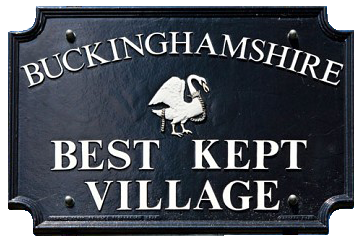
Gurney Cup Winners
2024
Previous Wins
Tindall Cup 2023
Gurney Cup
2022 - 2018 - 2016 - 1997 - 1973
Latest Updates

We operate a Neighbourhood Watch scheme in the village.
Note you only have to log in if you are an authorised contributor who needs to update pages. Visitors can view the whole site without logging in.

